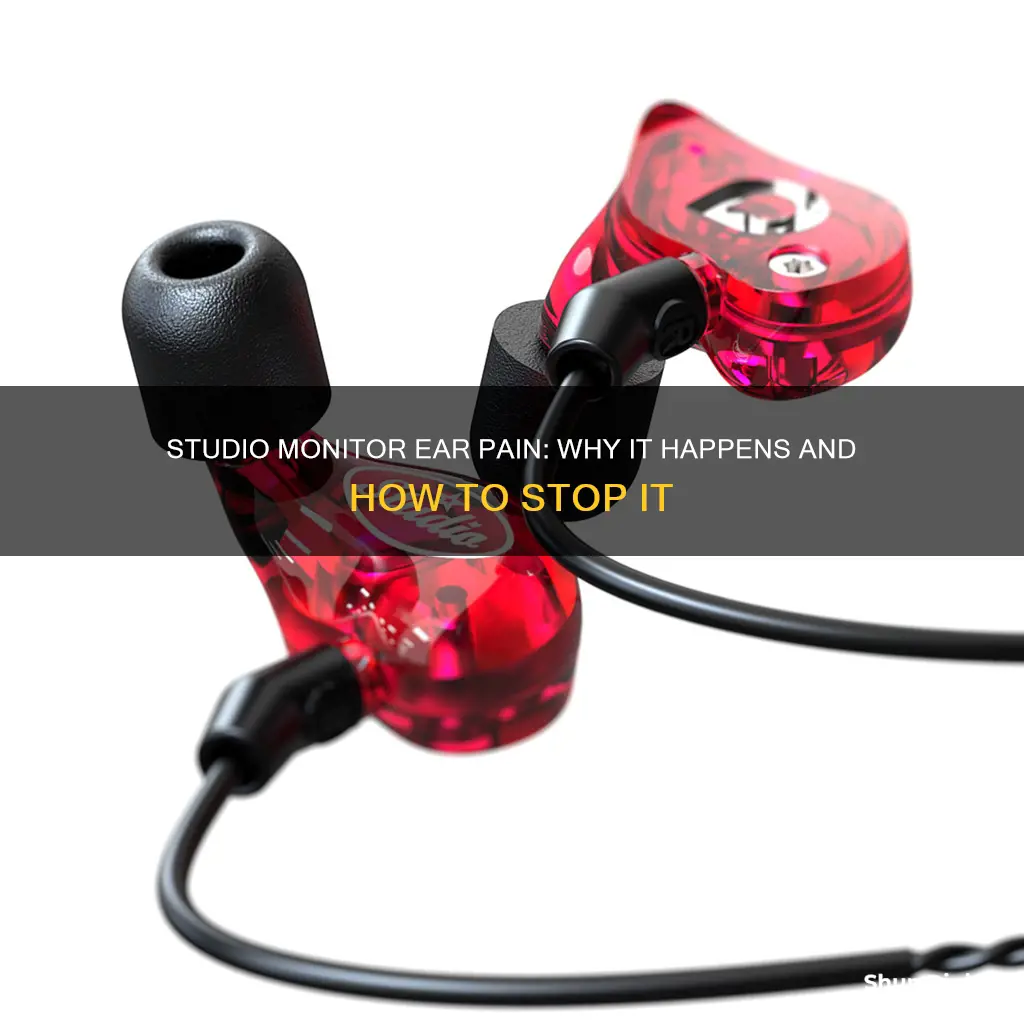
Studio monitors can cause ear pain due to a variety of factors, including prolonged exposure to high volumes, untreated rooms, and the design of the monitors themselves. Ear pain can also be caused by factors unrelated to the monitors, such as underlying health conditions or the listener's age. It is important to be mindful of safe volume levels and to take breaks during extended periods of monitor usage to prevent hearing damage and ear pain.
| Characteristics | Values |
|---|---|
| Studio monitors can cause ear pain due to | Extended high-frequency response of the monitors |
| Untreated room | |
| Mixing and mastering at high volumes | |
| Listening for extended periods | |
| Poor-quality equipment | |
| Individual hearing sensitivity | |
| Age |
What You'll Learn
- Studio monitors can be harsh-sounding, and prolonged exposure to them can lead to ear pain and fatigue
- Untreated rooms with hard surfaces and sparse furniture may worsen the pain
- The placement of monitors matters; they should be at ear level, with no surfaces for high frequencies to bounce off
- Some monitor models are more prone to causing ear pain, such as KRK Rokit 6's
- Individuals with tinnitus or hyperacusis may be more susceptible to ear pain from studio monitors

Studio monitors can be harsh-sounding, and prolonged exposure to them can lead to ear pain and fatigue
In addition, the environment in which studio monitors are used can also play a role. For example, listening in a crowded console or desktop environment can introduce problems with nearby reflections dominating the sound output. The placement of the monitors is crucial; they should be positioned above the desk, with the tweeters at ear level, forming an equilateral triangle with the listener's head. Additionally, untreated rooms or hard surfaces can cause sound reflections that affect the overall sound output.
Furthermore, individual sensitivity to sound can vary, and some people may be more susceptible to ear pain and fatigue. This could be due to conditions such as hyperacusis or misophonia, which can cause an aversive reaction to certain sounds. It is also important to consider the quality of the studio monitors, as cheaper options may have inherent distortion or poor reproduction of sound, leading to an unnatural and harsh listening experience.
To address ear pain and fatigue caused by studio monitors, there are several strategies that can be implemented. Firstly, ensuring that the monitors are properly positioned and that the room acoustics are treated with sound panels or acoustic foam can help reduce reflections and improve the overall sound quality. Secondly, taking frequent breaks during listening or mixing sessions is essential to give your ears a rest. Lastly, consider investing in higher-quality studio monitors known for being easier on the ears, such as those with ribbon tweeters or low distortion specifications.
Connecting a Second Monitor to Your iMac: A Step-by-Step Guide
You may want to see also

Untreated rooms with hard surfaces and sparse furniture may worsen the pain
The design of studio monitors, which are meant to "dissect music like a scalpel", can lead to ear pain. This is especially true when used in untreated rooms with hard surfaces and sparse furniture.
Sound waves bouncing off hard surfaces can cause reflections that interfere with the direct sound from the monitors, creating a challenging listening environment. This issue can be mitigated by adding sound-absorbing materials such as acoustic foam or cloth-covered panels to the room. These materials will help to scatter or absorb sound waves, reducing the number of reflections and improving sound intelligibility.
Additionally, sparse furniture in the room can contribute to the problem by providing fewer surfaces to absorb or deflect sound waves. This results in more sound reflections and a higher likelihood of sound interference. Addressing this issue may involve strategically placing furniture or sound-absorbing objects in the room to reduce the impact of reflections.
The combination of hard surfaces and sparse furniture can create a challenging acoustic environment that exacerbates the already harsh sound of studio monitors. Addressing these room acoustics through appropriate treatment can significantly improve the listening experience and reduce ear pain associated with prolonged exposure to studio monitors.
Blind Spot Monitor: A Worthless Safety Feature?
You may want to see also

The placement of monitors matters; they should be at ear level, with no surfaces for high frequencies to bounce off
The placement of studio monitors matters a great deal when it comes to preventing ear pain. Firstly, it is important to ensure that the tweeters of the monitors are positioned at ear level when you are sitting down. This ensures that the sound reaches your ears directly, without any reflections or distortions that could cause ear fatigue.
In addition, the monitors should be placed in such a way that there are no large surfaces for high frequencies to bounce off. This means avoiding placing the monitors directly on a desk, as the desk surface can reflect high frequencies, causing them to reach your ears microseconds after the direct sound. This can result in phase issues and comb filtering, leading to ear discomfort and fatigue. Instead, consider using monitor stands to raise the monitors off the desk, ensuring that there is enough space between the monitors and the desk surface.
The placement of the monitors in relation to your head is also important. Ideally, the monitors should form an equilateral triangle with your head, with each side of the triangle measuring around 2 meters. This setup helps ensure that you are positioned in the "sweet spot" for optimal sound imaging and reduces the likelihood of ear pain.
It is also worth noting that the acoustics of the room can play a significant role in preventing or causing ear pain. A room with many hard surfaces, such as an untreated room with sparse furniture, can create reflections and standing waves that can affect the sound and potentially cause ear discomfort. Consider treating the room with acoustic panels or sound-absorbing materials to improve the acoustics and reduce the risk of ear pain.
Understanding Monitor Hertz: A Guide to Finding Your Display's Hz
You may want to see also

Some monitor models are more prone to causing ear pain, such as KRK Rokit 6's
Some monitor models are more prone to causing ear pain, such as the KRK Rokit 6s. This is due to their harsh sound, particularly in the high frequencies, which can cause ear fatigue and pain. The issue is not exclusive to this model, however, as other KRK monitors have been known to cause similar discomfort. The problem may be exacerbated by the user's room acoustics, with untreated rooms or reflective surfaces leading to sound reflections and a build-up of certain frequencies.
The KRK Rokit 6s have been described as "exciting-sounding speakers" that are forward in the treble range, with "awful muddy low mids". This results in an unnatural reproduction of sound, which can be fatiguing and uncomfortable for the listener. The human ear is sensitive to these unnatural harmonics, and prolonged exposure can lead to ear pain and fatigue.
It is worth noting that not everyone experiences ear pain with the KRK Rokit 6s, as some users have reported being able to use them for years without issues. However, for those who are sensitive to high frequencies or have acute hearing, these monitors can be particularly uncomfortable.
To alleviate the issue, users have suggested adjusting the placement of the monitors, using monitor stands, and decoupling them from surfaces that may cause resonance. Acoustic treatment, such as absorption panels and bass traps, can also help reduce sound reflections and improve the listening experience. Additionally, it is important to maintain reasonable listening volumes and take frequent breaks to rest the ears.
In some cases, the issue may be due to a fault with the monitors themselves. It is recommended to check the cables, power supply, and audio settings before contacting the manufacturer for further assistance if the problem persists.
Warfarin Therapy: Monitoring Coagulation Studies for Safe Treatment
You may want to see also

Individuals with tinnitus or hyperacusis may be more susceptible to ear pain from studio monitors
Studio monitors can be quite harsh-sounding, and individuals with tinnitus or hyperacusis may be more susceptible to ear pain from them. Tinnitus is a condition where individuals experience ringing, whistling, clicking, or roaring sounds in their ears. Hyperacusis, on the other hand, is a rare hearing disorder where everyday sounds may seem unbearably loud and painful. Both conditions are associated with decreased sound tolerance and can be triggered or worsened by exposure to loud noises.
For individuals with tinnitus, certain studio monitors may aggravate their symptoms and cause ear pain. This could be due to the monitors' frequency response, with higher frequencies being more likely to trigger tinnitus. In addition, untreated rooms or reflections from nearby surfaces can also contribute to the issue. Acoustic foam or cloth-covered sound panels can help improve the sound intelligibility and reduce ear fatigue.
Hyperacusis can cause individuals to perceive ordinary sounds as painfully loud. This can include everyday noises such as a car engine, running water, or even the turning of pages in a book. The exact cause of hyperacusis is still being researched, but it is believed to be related to the brain's perception of sound and the functioning of the facial nerve. Individuals with hyperacusis may also experience other symptoms such as ringing in the ears, a feeling of fullness or pressure in the ears, and social isolation due to their sensitivity to sound.
Both tinnitus and hyperacusis can impact an individual's quality of life and mental health. The constant experience of intense, unpleasant sounds can lead to irritability, anxiety, and relationship issues. It is important for individuals experiencing symptoms of tinnitus or hyperacusis to seek professional help and not try to manage the symptoms on their own. While there may not be a standard treatment, therapies such as sound therapy, cognitive-behavioral therapy (CBT), and tinnitus retraining therapy (TRT) can help reduce the physical symptoms and provide coping strategies.
Ankle Monitors: What They Look Like and How They Work
You may want to see also
Frequently asked questions
Studio monitors can cause ear pain due to prolonged exposure to high sound pressure levels (SPL) and certain frequencies. It is important to keep the volume within a safe range and limit the duration of exposure to loud sounds to prevent hearing damage.
According to Thomas Lund, a senior technologist at Genelec, the safe zone for sound exposure is 80 dB or lower for an 8-hour period. For higher SPL, reduce the amount of time spent listening to loud music to prevent hearing damage.
Hearing loss, tinnitus (ringing in the ears), and ear pain are all signs of potential hearing damage. If you experience any of these symptoms, it is important to see a hearing specialist for an evaluation.
Yes, some studio monitors may be better suited for individuals with tinnitus or sensitive hearing. The ADAM A5X and the FOCALCMS65 are examples of monitors that are designed to be easier on the ears. Additionally, monitors with ribbon tweeters tend to be less harsh than those with dome tweeters.
Ensure that your studio monitors are set up correctly. They should be placed on stands or monitor arms so that they are at ear level and form an equilateral triangle with your head. This will help reduce the impact of high frequencies and prevent ear fatigue.







